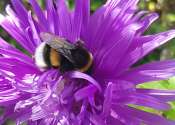Study shows organic beekeeping rivals conventional methods for bee health, productivity
Honey bee colonies managed using organic methods were as healthy and productive as those managed in conventional systems, while avoiding the use of synthetic pesticides to control pests and pathogens inside the hive, according ...









